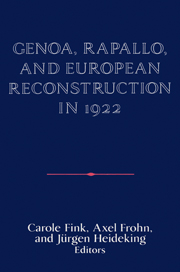Book contents
- Frontmatter
- Introduction
- 1 Beyond Revisionism: The Genoa Conference of 1922
- 2 The Genoa Conference of 1922: Lloyd George and the Politics of Recognition
- 3 A Rainy Day, April 16, 1922: The Rapallo Treaty and the Cloudy Perspective for German Foreign Policy
- 4 Reparations in 1922
- 5 Germany and the United States: The Concept of World Economic Interdependence
- 6 American Policy Toward Debts and Reconstruction at Genoa, 1922
- 7 French Plans for the Reconstruction of Russia: A History and Evaluation
- 8 The Oil Problem and Soviet-American Relations at the Genoa Conference of 1922
- 9 Italy at the Genoa Conference: Italian-Soviet Commercial Relations
- 10 The European Policy of Czechoslovakia on the Eve of the Genoa Conference of 1922
- 11 The Genoa Conference and the Little Entente
- 12 The Role of Switzerland and the Neutral States at the Genoa Conference
- 13 The Genoa Conference and Japan: A Lesson in Great-Power Diplomacy
- Maps
- Appendix
- Bibliography
- Contributors
- Index
9 - Italy at the Genoa Conference: Italian-Soviet Commercial Relations
Published online by Cambridge University Press: 05 January 2013
- Frontmatter
- Introduction
- 1 Beyond Revisionism: The Genoa Conference of 1922
- 2 The Genoa Conference of 1922: Lloyd George and the Politics of Recognition
- 3 A Rainy Day, April 16, 1922: The Rapallo Treaty and the Cloudy Perspective for German Foreign Policy
- 4 Reparations in 1922
- 5 Germany and the United States: The Concept of World Economic Interdependence
- 6 American Policy Toward Debts and Reconstruction at Genoa, 1922
- 7 French Plans for the Reconstruction of Russia: A History and Evaluation
- 8 The Oil Problem and Soviet-American Relations at the Genoa Conference of 1922
- 9 Italy at the Genoa Conference: Italian-Soviet Commercial Relations
- 10 The European Policy of Czechoslovakia on the Eve of the Genoa Conference of 1922
- 11 The Genoa Conference and the Little Entente
- 12 The Role of Switzerland and the Neutral States at the Genoa Conference
- 13 The Genoa Conference and Japan: A Lesson in Great-Power Diplomacy
- Maps
- Appendix
- Bibliography
- Contributors
- Index
Summary
At nine o'clock on the morning of April 6, 1922, a special three-carriage train entered the railway station in Genoa. On board was a Soviet delegation of about sixty people, invited to participate in the economic and financial conference that was to convene there. This was the first international meeting since the revolution in which the Russian Soviet Federated Socialist Republic, as it was then called, was to participate.
Sturdy carabinieri wearing three-cornered hats surrounded the station, and policemen in long black jackets and with whips in their hands patrolled the platform. Nearby, the prefect of Genoa and the general secretary of the conference, Romano Avezanna, were waiting to welcome their guests according to diplomatic protocol. The conference staff wore the official badge on their arms, a blue silk band with white five-pointed stars.
When Chicherin, wearing a top hat and yellow gloves, descended from the train, one of the journalists made this hurried remark: “By these means the Bolsheviks want to keep up the pretence that bolshevism is not poles apart from the European legal order. This is why they make a show of the hats and gloves. Perhaps tomorrow they will show up in tails!”
During the next days, the charming seaside resort of Santa Margherita Ligure, where the Soviet delegation resided, became the scene of a veritable pilgrimage. Hundreds of curious people poured into the eastern Ligurian coast just to see with their own eyes the “new aliens.”
- Type
- Chapter
- Information
- Genoa, Rapallo, and European Reconstruction in 1922 , pp. 159 - 170Publisher: Cambridge University PressPrint publication year: 1991



